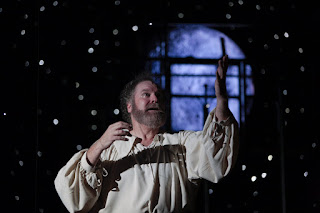 Well, we're a little more than halfway through the season - and the IRNE awards are next week - so I thought now might be a good time for a quick round of Hubbies, my own virtual awards for acting, design and direction on the local theatre scene (someday to be presented in the shape of Michael Phelps, at left, sculpted in lucite).
Well, we're a little more than halfway through the season - and the IRNE awards are next week - so I thought now might be a good time for a quick round of Hubbies, my own virtual awards for acting, design and direction on the local theatre scene (someday to be presented in the shape of Michael Phelps, at left, sculpted in lucite).Alas, unlike another local critic (who shall remain anonymous, because that's how he signs his reviews!) I can't opine that the current season has been better than ever, despite the recession. Because actually it has seemed pretty weak to me (indeed, the most exciting intellectual material on local stages has been in our dance and musical performances, not our theatrical ones). The ART and the Huntington have continued to stumble, and there have been subtle misfires - along with some very fine individual acting turns - from SpeakEasy, the New Rep and the Lyric.
In fact, the best theatrical news so far this year has been on the fringe, and probably the strongest productions I've seen have been:
 Dark Play, or Stories for Boys, at the Apollinaire Theatre: Hubbies for director Danielle Fauteux Jacques, and the entire ensemble of actors: Mark Vashro and Erez Rose (at left), Christine Busler, Brian Quint and Lorna Nogueira.
Dark Play, or Stories for Boys, at the Apollinaire Theatre: Hubbies for director Danielle Fauteux Jacques, and the entire ensemble of actors: Mark Vashro and Erez Rose (at left), Christine Busler, Brian Quint and Lorna Nogueira. And another "Best Ensemble" Hubbie must go the cast of The Pain and the Itch, at Company One: Nancy Carroll, Aimee Doherty, Philana Mia, Joe Lanza, Dennis Trainor, Jr., Cedric Lilly, and Rebecca Skye Hamberg, directed by M. Bevin O'Gara.
A runner-up Hubbie should go to the performers of Howard Zinn's Daughter of Venus at the Suffolk University and Boston Playwrights' Theatres: Paul Langton, Ken Cheeseman, Angie Jepson, and Stephen Russell, with a special citation to Alex Pollock. Directed by Wesley Savick.
And the cast of A View of the Harbor at Merrimack Rep deserves recognition as well: Stephanie Fieger, Kyle Fabel and Andrea Cirie, with a special citation to Anderson Matthews, all under the direction of Charles Towers.
Individual performances that have given me particular pleasure over the last few months have included:
 Paula Plum (right) and Robert Saoud, The New Century (SpeakEasy Stage);
Paula Plum (right) and Robert Saoud, The New Century (SpeakEasy Stage);Aimee Doherty, Cabaret (New Rep) (as well as The Pain and the Itch, Company One);
Stacy Fischer, Uncle Vanya (Boston Art Theatre) and Fool for Love (New Rep);
Will Lyman, Exits and Entrances (New Rep);
Nancy Carroll, The Year of Magical Thinking (Lyric Stage) as well as The Pain and the Itch, Company One;
 Cheryl McMahon, Cabaret (New Rep) and Cat on a Hot Tin Roof (at left, with Spiro Veloudos, Lyric Stage);
Cheryl McMahon, Cabaret (New Rep) and Cat on a Hot Tin Roof (at left, with Spiro Veloudos, Lyric Stage);Mark Peckham, The Cherry Orchard (Nora Theatre Co.);
Sirena Abalian, Seussical (Wheelock Family Theatre);
Michael Forden Walker, The Duchess of Malfi (Actors' Shakespeare Project);
Tracy Oliverio, The Random Caruso (CentaStage);
and Tim Ruddy, Swansong (Tir Na).
There have also already been enough outstanding designs on our stages to merit a round of Hubbies. Admittedly, in scope and depth, Francis O'Connor's work on Two Men of Florence stands alone - but companies with fewer resources than the Huntington have been working smaller-scaled miracles on their stages as well. So without further ado:
Francis O'Connor, Two Men of Florence, Huntington Theatre (set and costumes).
Campbell Baird, Tranced, Merrimack Rep;
Richard Wadsworth Chambers, A View of the Harbor, Merrimack Rep;
Cristina Todesco, The Pain and the Itch, Company One, and The New Century, SpeakEasy Stage; and
Gail Astrid Buckley, costumes, The New Century, SpeakEasy Stage;
Well, that's all for now; we'll have an update with more Hubbies - and hopefully another sexy shot of Michael - in June.

























